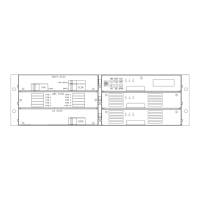Troubleshooting Sageon Micro Power Module Manual
PM990-4207-00, Rev 6
6-2
Symptom Likely Causes Action
Battery current indicates 0A when
more than 5A is flowing in the
battery or is inaccurate at low
currents (<5A)
DC hall effect transducer or wiring
is faulty.
Current transducer sensitivity is too
low for 1A measurement
Service the DC current transducer in
the BDM – check the wiring is intact
and still connected properly, or
replace the DC CT is suspected to be
faulty
Revise size of DC CT full-scale
value for the size of the load and
battery charging requirements.
Load current indicates 0A when
known to be >5A
Number of RECTIFIER
incorrectly set too low or the battery
current FS is set too high. The load
current is calculated from the sum of
the RECTIFIER currents minus the
measured battery currents
RECTIFIERs in the Controller Base
menu matches the actual number of
rectifier modules installed.
Check the Battery DC CT rated full-
scale value is correctly set in the
Base menu.
One unit is alarmed as HVSD (high
voltage shutdown) and is latched off.
The unit has developed a fault that
causes it to output a voltage above
the HVSD protection limit and has
been supplying load current while
above this voltage limit.
A random event on the DC bus has
occurred that forced a unit into
HVSD.
Replacing the rectifier module is
recommended. However, a random
event may have triggered the HVSD
and to determine if the unit has a real
fault, the HVSD latched alarm can
be reset using the “Reset Latched
Alarm” function in the Controller
RECTIFIER Menu. (If the system
does not have any batteries, cycling
the AC power will h
effect). If the unit does not recover
by latching off again, it is faulty.
“RECTIFIER
activated
One or many RECTIFIERs are off
due to AC power failure, internal
faults, incorrect command signal
from Controller or all rectifiers are
in current limit
Check the AC power and restore.
Replace faulty rectifier modules.
Check for DC bus overload faults.
All units are latched off as HVSD
Absolute Overvoltage shutdown
protection activated. The system is
likely to have no load and without a
battery. An event on the DC bus has
caused the voltage to exceed 70V for
48V systems or 35V for 24V
systems. The event could be caused
either by a faulty rectifier or other
equipment connected to the bus.
Add a small amount of load (>2A
per rectifier) to the system and check
for a faulty rectifier.
Check for other faulty equipment
connected to the bus that could cause
the overvoltage transient.
Use the “Reset Latched Alarm” from
the Controller to reset the system.
A rectifier is indicating
“RECTIFIER
Response” on the Controller
RECTIFIER display
An AC failure to the rectifier is the
most likely cause. While the
rectifier internal power rails are still
available, the unit will communicate
with “RECTIFIER
Off” if the AC
has failed on its input. Once the
internal power dies, the unit will no
longer communicate and Controller
will indicate “No Response”.
Check the AC feed to the rectifier
for a tripped circuit breaker, blown
fuse or faulty connection.

